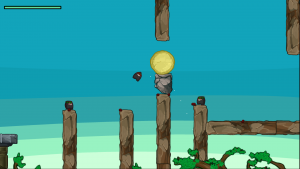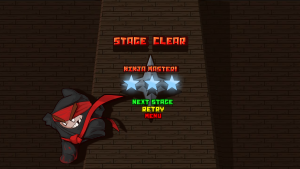Quick, cute and just a little bit bloody; Super Spring Ninja is an entertaining exercise in assassination and aerodynamics.
Ever felt such hatred toward a rival ninja clan that you decided to hurl yourself head-first towards them in an effort to reduce them into a gory mess, all the while avoiding all manner of traps, explosives and gravity itself? Neither have I, but the titular Super Spring Ninja certainly has! The results, while not perfect, come together in an entertaining experience from developer Demon Sword Games.

Touting itself as something of a mash-up between Angry Birds and Super Meat Boy, Super Spring Ninja is a game that’s all about reaching the end goal (or rather, end scroll) while taking out as many ninjas in green headbands as possible. The influence of Angry Birds is clear to see in a game that’s all about planning your trajectory to take out static opponents, and while the comparison to Super Meat Boy is perhaps a little more tenuous, its mechanics working together with its collection of traps, pitfalls and the like help form a game that sets itself apart from both.
Super Spring Ninja spreads itself out over a collection of sixty levels. Each can be completed with a one, two or three star rating. Simply put, the players objective is to reach the scroll at the end of the level while taking out as many enemy ninjas as possible. This is achieved, as one does, by launching your ninja across the screen, landing on switches, pushing boulders and crates and, of course, eliminating your enemies. You can launch an unlimited number of jumps while in mid-air, meaning you’re never on the ground for long. The existence of a stamina meter suggests this was perhaps not always the plan, but as it refills immediately after launching it seems to serve no actual purpose.
The game’s controls are simple and easy to grasp, consisting of clicking and dragging to launch your ninja. A tap of the space bar inverts the default controls. I personally found doing so far more intuitive than the default setting. In a move that turns the tables on goombas and minions of Dr. Cortex alike, simply touching an enemy will cause them to explode into a gooey mess, though you’ll usually find yourself gracefully landing headfirst on their scalp. It’s hardly God of War, but suffice it to say that when an enemy meets their untimely end, you’ll certainly know about it.

The game is not as clear as it could be on how the its star ratings are achieved, but it seems that numerous deaths result in one star, while missing an enemy ninja or two will result in a two star rating. The occasional level didn’t apply to this and would hand out 3 stars regardless of deaths. A rating of three stars in every level is certainly doable, with some of course proving more difficult than others.
While nothing in the game is particularly challenging – a few tries will see you reach that three star rating – Super Spring Ninja is prone to a handful of difficulty spikes. One moment I found myself completing a level with ease, only for the next to take much longer. The following level would then be easier than either. This is particularly true toward the end of the game, which can make new levels a little underwhelming at times, but isn’t a major issue.
Obstacles consist mostly of pitfalls, spinning saw-blades and sharpened spikes. These safety hazards glow red when you get near to signify that you are in danger. Other objects glow too, such as boulders or destructible rocks. Boulders glow yellow, showing that they can be pushed but pose a threat if you happen to be directly underneath. Glowing green rocks show that they can be destroyed without harming the player, though as boulders tend to be resting just above, this isn’t always the case. It’s a handy system to have in place and lends itself to the game’s accessibility, particularly when coupled with the very accurate trajectory indicator which will almost always show exactly where your ninja will land. On top of this, time slows considerably when launching a new jump in mid-air, giving the player a great degree of control over where they go (or what they’ll crash into) next.

The game’s art style is something of a mixed bag: the visuals are clear and the screen is never too cluttered, and while the ninja design is equal parts cute and sadistic, there is little beyond that. Backgrounds are fairly standard, mostly consisting of blue skies and Bowser’s Castle-esque environments. Beyond that, a lack of any characters beyond the identikit ninjas does little to add some much needed variety. The one exception to this is the existence of several ‘silhouette’ levels in which the usual scene is replaced with shadows against a sunset or night sky. These levels are a great deal more pleasant to look at, though they can at times make it easier to miss certain objects (switches in particular). These presentation issues likely stem from the game’s history of starting out on Newgrounds (as a game called Spring Ninja). While the style certainly fits a Newgrounds game, preserving it for a Steam release doesn’t work quite as well.

Super Spring Ninja’s main strength lies in being played in short bursts. Levels take a maximum of a few minutes each to complete and, while this presents the ‘one more level’ dilemma, it works well as a short distraction rather than a game you’ll be wanting to plough through all at once; something perfectly preserved from its browser game origins. This of course raises the question of whether or not it would have worked better as a mobile game and, in all likelihood, a phone might have made better use of such a title.
As far as polish is concerned, Super Spring Ninja proves to be somewhat inconsistent. The issue is less with an overall sense of negligence in that regard, but more to do with certain points in the game. Restarting a level, for example, causes the sound effect for being awarded stars to play over and over until you quit the game. A handful of other bugs bugs (which the developer has acknowledged the existence of) exist, such as glitching through walls or random restarts. These are, thankfully, a rarity. It is also worth noting that the game ends rather unceremoniously: after finishing the last level, there is no victory screen, nor is the player returned to the main menu. Instead, after selecting ‘Next Level’ the player will be rewarded with a level devoid of any scenery – it was only by exiting and re-entering the game that I’d realised I’d finished it.
Despite this, there’s an overall sense of confidence in the game as a whole. Its levels are cleverly designed with levels triggering their own sets of chain reactions to which the player must respond, and many, particularly toward the end of the game, were cleverly thought out. As such, while the game is perhaps not a ground-breaking breath of fresh air, it sticks to what it knows, and the results certainly pay off.
All in all, Super Spring Ninja is a solid title despite some rough edges. I found myself looking forward to returning to it, though the lack of any significant challenge means it can be completed to 100% very quickly, making replayability less enticing than it could be. Still, for $2.25/£1.99 (with a 25% discount at time of writing) it’s a title worth picking up to play when you find yourself with a few minutes to spare.
Note: At the time of writing, Super Spring Ninja’s Steam page contains a trailer and screenshot showcasing content not currently in the game, hinting either at cut content or something new down the line; it is worth noting that the game was planned for Early Access, so these screenshots may indeed be works in progress.